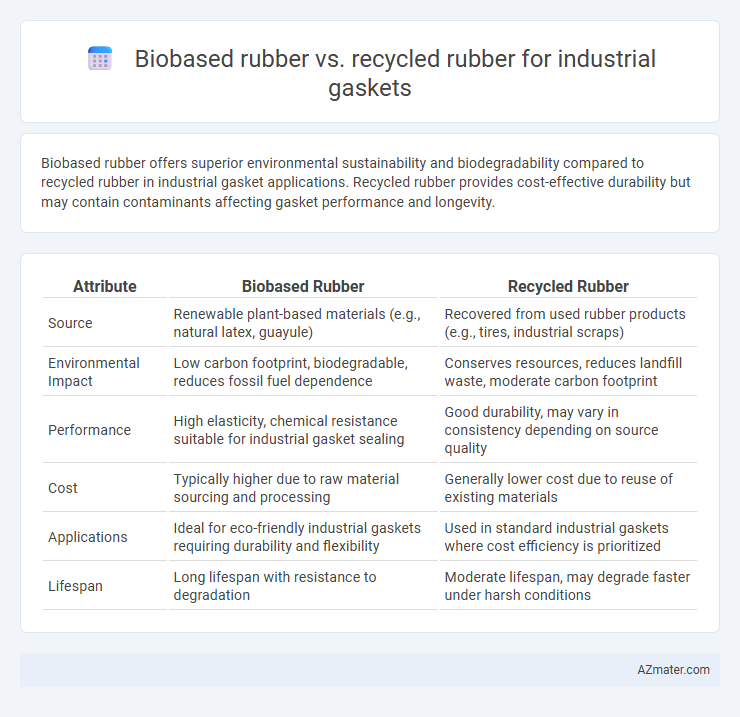Biobased rubber offers superior environmental sustainability and biodegradability compared to recycled rubber in industrial gasket applications. Recycled rubber provides cost-effective durability but may contain contaminants affecting gasket performance and longevity.
Table of Comparison
| Attribute | Biobased Rubber | Recycled Rubber |
|---|---|---|
| Source | Renewable plant-based materials (e.g., natural latex, guayule) | Recovered from used rubber products (e.g., tires, industrial scraps) |
| Environmental Impact | Low carbon footprint, biodegradable, reduces fossil fuel dependence | Conserves resources, reduces landfill waste, moderate carbon footprint |
| Performance | High elasticity, chemical resistance suitable for industrial gasket sealing | Good durability, may vary in consistency depending on source quality |
| Cost | Typically higher due to raw material sourcing and processing | Generally lower cost due to reuse of existing materials |
| Applications | Ideal for eco-friendly industrial gaskets requiring durability and flexibility | Used in standard industrial gaskets where cost efficiency is prioritized |
| Lifespan | Long lifespan with resistance to degradation | Moderate lifespan, may degrade faster under harsh conditions |
Introduction to Industrial Gaskets and Rubber Materials
Industrial gaskets require durable and flexible materials to ensure reliable sealing under high pressure and temperature conditions. Biobased rubber, derived from renewable resources like natural latex or plant oils, offers enhanced sustainability and biodegradability compared to recycled rubber, which is sourced from reclaimed vulcanized materials and emphasizes waste reduction and cost efficiency. Selecting between biobased and recycled rubber depends on balancing environmental impact, mechanical properties, and application-specific performance demands in industrial sealing solutions.
Defining Biobased Rubber: Sources and Properties
Biobased rubber for industrial gaskets is derived from renewable plant sources such as natural latex from Hevea brasiliensis trees and alternative crops like guayule or dandelion. This type of rubber exhibits high elasticity, excellent resilience, and biodegradability, making it an eco-friendly option compared to conventional synthetic rubbers. Its molecular structure offers superior resistance to heat, abrasion, and chemicals, crucial for demanding gasket applications in industrial environments.
Understanding Recycled Rubber: Processes and Characteristics
Recycled rubber for industrial gaskets is produced through mechanical grinding and devulcanization processes that break down used rubber materials into reusable particles. These processes retain essential properties such as elasticity, durability, and heat resistance, making recycled rubber a cost-effective and sustainable option. Compared to biobased rubber, recycled rubber offers consistent performance derived from reclaimed tires and industrial waste, while also reducing landfill impact and conserving raw materials.
Environmental Impact: Biobased vs Recycled Rubber
Biobased rubber for industrial gaskets significantly reduces carbon footprint by utilizing renewable resources such as natural latex from rubber trees, decreasing reliance on fossil fuels. Recycled rubber lowers environmental impact by diverting waste from landfills and minimizing raw material extraction, but may involve energy-intensive processing and potential contamination issues. Choosing biobased rubber supports sustainable cultivation and biodegradability, while recycled rubber emphasizes circular economy practices and resource efficiency in industrial applications.
Performance Comparison: Durability and Resistance
Biobased rubber exhibits superior chemical resistance and environmental sustainability but may show slightly lower abrasion resistance compared to recycled rubber in industrial gasket applications. Recycled rubber generally offers enhanced mechanical strength and durability, making it suitable for high-stress environments where gasket longevity is critical. Performance differences should be evaluated based on specific industrial conditions, such as temperature extremes and exposure to oils or solvents, to optimize gasket lifespan and reliability.
Cost Analysis: Biobased Rubber vs Recycled Rubber
Biobased rubber typically incurs higher initial costs due to raw material sourcing and processing complexities compared to recycled rubber, which benefits from lower material expenses and reduced waste management fees. Operational savings from biobased rubber's enhanced durability and chemical resistance may offset upfront expenses over the gasket lifecycle, but recycled rubber offers immediate cost advantages in large-scale industrial applications. Cost analysis must evaluate not only unit price but also lifecycle performance, supply chain stability, and environmental compliance factors influencing total expenditure for industrial gaskets.
Chemical Compatibility and Industrial Applications
Biobased rubber offers superior chemical compatibility with aggressive solvents and oils commonly found in industrial gasket applications due to its natural polymer composition, enhancing durability and lifespan. Recycled rubber, while cost-effective and environmentally sustainable, may exhibit variable chemical resistance depending on the source material and processing, limiting its use in high-performance or corrosive environments. Industrial gaskets made from biobased rubber are preferred in sectors like chemical processing and food manufacturing, whereas recycled rubber gaskets are suitable for less demanding applications such as water sealing and general machinery maintenance.
Regulatory Standards and Certifications
Biobased rubber for industrial gaskets aligns with sustainability certifications such as USDA BioPreferred and meets REACH and RoHS regulatory standards, ensuring low environmental impact and compliance with chemical safety requirements. Recycled rubber often complies with ASTM and ISO standards related to material reuse and durability but faces stricter scrutiny under regulations like the European Union's End-of-Life Vehicle Directive due to potential contaminants. Both materials require certifications like UL and FDA for industrial applications, but biobased rubber provides superior compliance with emerging green procurement policies and eco-label standards.
Market Trends and Future Outlook
Biobased rubber for industrial gaskets is gaining market traction due to rising environmental regulations and increasing demand for sustainable manufacturing materials, with a projected CAGR of over 8% through 2030. Recycled rubber continues to hold significance by offering cost-effective solutions and reducing landfill waste, driven by circular economy initiatives across automotive and construction industries. Innovations in polymer chemistry and growing government incentives are expected to further propel the adoption of biobased rubber, while advanced recycling technologies enhance the performance and applications of recycled rubber in gasket production.
Making the Right Choice: Key Considerations for Industries
Choosing between biobased rubber and recycled rubber for industrial gaskets depends on factors like environmental impact, performance requirements, and cost-effectiveness. Biobased rubber offers renewable sourcing and better biodegradability, while recycled rubber contributes to waste reduction and lower material expenses. Industries should evaluate gasket application conditions, durability needs, and sustainability goals to make the right choice.

Infographic: Biobased rubber vs Recycled rubber for Industrial gasket
 azmater.com
azmater.com